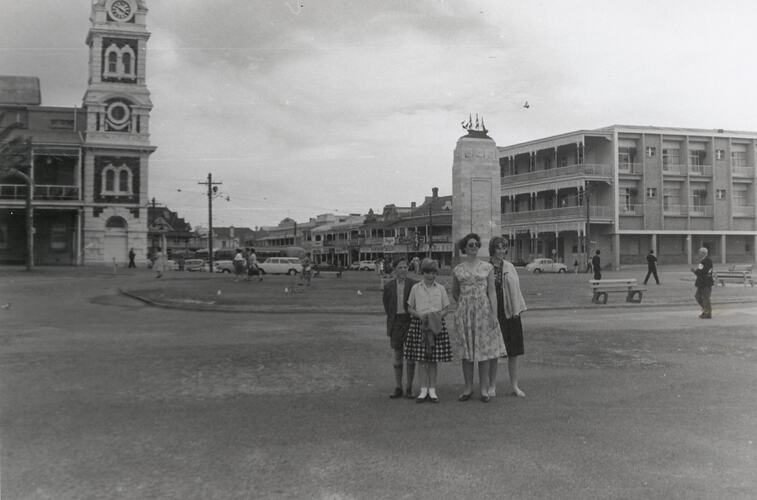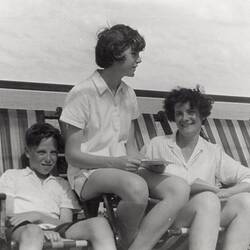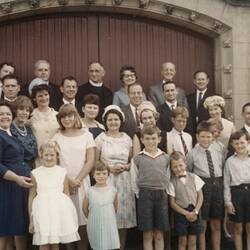Summary
Digital photograph of David, Jennifer, Mary and Patricia Ward (left to right) at Moseley Square, Glenelg, on 12 December 1961 during their visit to Adelaide on their voyage from England. The Glenelg Town Hall (1877), in the background, was designed by Edmund William Wright, (18724-1888), architect. One of 84 digital photographs relating to the Ward family migration experience including their life in England, their voyage in 1961 to Australia and their settlement in Melbourne.
The stone monument behind the family is the Pioneer Memorial, unveiled in 1936 as part of the centenary celebrations of South Australia. It was designed by G. Beaumont Smith to commemorate the foundation of South Australia and to honour the early settlers. Crowning the tip of the 12.9 metre high monument of Kapunda marble with its base of Murray Bridge granite is a bronze replica of HMS 'Buffalo', the ship which brought the first migrants to South Australia from England in 1836.
Part of a large collection of material relating to the migration and settlement of British migrants to Australia in the 1960s under the 'Bring Out a Briton' Scheme. It documents in particular both the migration experiences of James and Mary Ward and their three children who arrived in Melbourne on the 'TSS Stratheden' from Yorkshire in December 1961; and the Burke Road East Malvern Methodist Church's sponsorship of a number of English families, including the Wards, under the Scheme. The Church's support included temporary accommodation for assisted families in a neighbouring house. The 'Bring Out a Briton' Scheme (1957-1982) was part of a Commonwealth Government initiative which offered subsidised ship fares, accommodation and support to encourage migration from the UK to Australia after World War II.
Description of Content
A group of four - a boy, young girl, a woman and an older girl - standing together in a plaza in front of a stone memorial with a small bronze ship atop, and in the background, buildings including one with a brick and stone clocktower and opposite a three-storey building with cast-iron lace verandahs.
Physical Description
Digital photograph.
Significance
The Ward/Barlow Families collection is of national significance in documenting British assisted migration to Australia post-World War II. The collection provides a comprehensive snapshot from the commencement to completion of a British assisted migration experience and illuminates post-war immigration policies and procedures which favoured British immigration into Australia.
The collection of almost 400 items comprises a unique body of documentation with intersections between personal, community and government narratives that explore British post-World War II assisted migration. It includes photographs, personal correspondence, documents and objects offering a rare glimpse into the role of the Australian and British governments, Methodists Church sponsorship and community engagement in assisting and welcoming British immigrants to Australia. Assisted British migration was a constant theme of Australian immigration history until the early 1980s. Government initiatives such as the 'Bring Out A Briton' scheme had an enormous impact on the composition and size of the Australian population, making the Ward/Barlow collection of broad social and political historical significance.
More Information
-
Collection Names
-
Collecting Areas
Migration & Cultural Diversity, Childhood, Leisure, Home & Community
-
Acquisition Information
Donation from William & Jennifer Barlow, 22 Feb 2012
-
Person Depicted
Mrs Jennifer Barlow, Glenelg, Greater Adelaide, South Australia, Australia, 12 Dec 1961
-
Person Depicted
Mrs Mary H. Ward, Glenelg, Greater Adelaide, South Australia, Australia, 12 Dec 1961
-
Person Depicted
Miss Patricia Ward, Glenelg, Greater Adelaide, South Australia, Australia, 12 Dec 1961
-
Person Depicted
David Ward, Glenelg, Greater Adelaide, South Australia, Australia, 12 Dec 1961
-
Format
Digital file, Black & White
-
Classification
-
Category
-
Discipline
-
Type of item
-
Keywords
English Immigration, Migration & Settlement, Migration Schemes, Immigration, Migrants, Assisted Immigration, Parks, Sculpture, Town Halls, Memorials, Streetscapes



